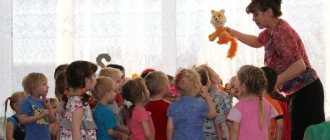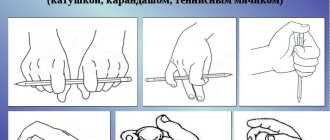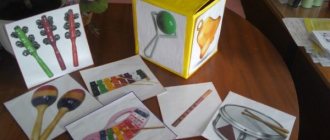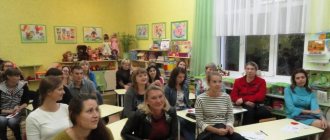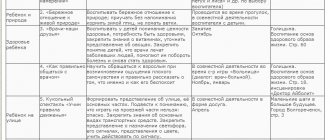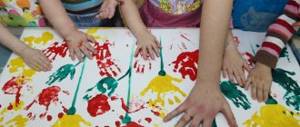Making pictures from parts
There is a lot of literature on this topic, I use these manuals:
- Children's health kit;
- A set of pictures on social development
- Illustrations on children's speech activity.
I also use homemade materials in my work, download pictures from the Internet and make games. So, that was a small digression, let's get back to the topic of conversation.
A drawing that is divided along straight lines into several parts is split. A preschooler should not think about the shape of a detail in a drawing; he concentrates on the full image.
When a child collects a drawing, he must imagine what he is collecting, what image he will get. In this case, he must correlate the pieces with the image so that the correct place is allocated to it. Otherwise the illustration will not work. This requires concentration, seriousness, and attentiveness from children.
When folding cut images, the baby begins to realize the objective integrity and compose an illustration from parts. He trains his memory, develops thinking, and spatial orientation. Drawings are great for improving fine motor skills. By consolidating knowledge about objects and phenomena, assembling a whole from pieces, the goal of the cut-out pictures game is formed.
From simple to complex
At first it is better to use the simplest designs with a small number of individual pieces. The image should be familiar to the baby. A good option is two similar pictures, one of which is divided into 2 parts. In this case, one can be a sample.
After the child masters this fun, he will not need an example picture. For this game, drawings from coloring books or old books will be useful. It will be much more interesting if you draw them yourself. Use bright, but not irritating colors.
First, cut the images into two, then into three parts. Then increase the number of pieces gradually when the child folds the previous drawing on his own. You should know that the number of elements collected increases, and their size decreases. There are times when a baby puts together pictures with large pieces easier.
The number of items should be selected in accordance with the age and special qualities of your child.
Cutting pictures for kindergarten
Very often in kindergarten I involve older children in making such games for younger children, and preschoolers are happy to help me. But at the same time, I am pursuing my goals, my task is not only to attract a child to artistic work, but also to teach how to cut paper, while developing children’s hands and fingers.
Pay attention to the “Games” section, where you will find a lot of useful material.
The game of cut pictures is widely used in speech therapy activities with preschool children of the middle and senior groups. A speech therapist works with them and uses these games in his work.
At every age, starting from 1.5 - 3 and continuing up to 7 years, the child is very interested in this fun, because with the help of it he learns the alphabet, toys, professions, transport, etc.
For preschoolers in the preparatory group, it is interesting to conduct such fun activities in mathematics. When compiling examples, I use the following pictures: in the upper part, for example, animals, toys or any objects, and in the lower part there is a number with the number of objects depicted in the picture. Such cut-out pictures for preschoolers can also be used to compose problems. An important indicator for assessing intellectual development in children is the success of putting together pictures from parts.
Didactic games on art activities for the second junior group
MBDOU Temnikovsky combined kindergarten "Golden Cockerel"
Didactic games for art classes in kindergarten"
for the second younger group.
Performed:
Ilyukhina N.A.
2018
Sometimes it can be very difficult to explain some material to a child. And of course it’s even more difficult to explain it so that he remembers it. And here didactic games come to the aid of the teacher. They are used in the educational process from the very beginning of a child’s learning to draw. I bring to your attention examples of such games that I use in my work.
1. Game “Colored baskets”
The first game is used with very young children and is called “Colored Baskets”. Purpose of the game: the game is aimed at learning colors by children 2.5-3.5 years old, memorizing the names of primary colors, developing the speech skills of preschoolers, developing observation and memory. Progress of the game:
children are asked to collect mixed up objects in baskets, the child draws any card, but he must put it in a basket of the same color, while loudly calling out the color and the object he chose.
2. Game “Bottom of the Sea”
Purpose of the game: development of artistic composition skills, development of speech, logical thinking, memory. A very common game that can be used not only in art activities, but also in other educational areas. The children are shown the seabed (empty), and it must be said that all the sea inhabitants wanted to play “Hide and Seek” with us, and in order to find them we need to guess riddles about them. The one who guessed correctly puts the resident in the background. The result is a complete composition. The teacher motivates children to perform visual activities. (Good to use with middle and older groups). In the same way, you can study with children other themes of plot compositions: “Summer Meadow”, “Forest Dwellers”, “Autumn Harvest”, “Still Life with Tea”, etc. You can invite several children to the board and ask them to make different compositions from the same objects. This game develops intelligence, reaction, and compositional vision.
3. Game “Painted Horses”
When consolidating knowledge of folk paintings or when conducting monitoring in senior and preparatory groups, you can use this simple game. Goal: to consolidate knowledge of the main motifs of Russian folk paintings (“Gzhel”, “Gorodets”, “Filimonovo”, “Dymka”), to consolidate the ability to distinguish them from others, to name them correctly, to develop a sense of color. Progress of the game:
the child needs to determine in which clearing each of the horses will graze, and name the type of applied art based on which they are painted.
4. Game “Magic Landscape”
One of the most difficult topics is, of course, the study of perspective in a landscape - distant objects seem smaller, near ones larger. It is also more convenient to use the game for this. Purpose of the game: to teach children to see and convey the properties of spatial perspective in drawings, to develop the eye, memory, and compositional skills. Progress of the game:
The child needs to place trees and houses in pockets according to their size, in accordance with their prospective distance. (preparatory group).
5. Game "Collect a landscape"
Using the example of a landscape, it is also convenient to develop a sense of composition and knowledge of natural phenomena. To do this, it is convenient to use this didactic game. Purpose of the game: to develop compositional thinking skills, consolidate knowledge of seasonal changes in nature, consolidate knowledge of the concept of “landscape,” develop observation and memory. Progress of the game:
the child is asked to compose a landscape of a certain season (winter, spring, autumn or winter) from a set of printed pictures; the child must select objects corresponding to this particular time of year and, using his knowledge, build the correct composition.
6.Game “Arrange and count the nesting dolls”
Purpose of the game: to consolidate knowledge about the Russian nesting doll, develop the ability to distinguish this type of creativity from others, develop ordinal counting skills, eye, and reaction speed. Progress of the game:
There are pieces of paper with drawn silhouettes of nesting dolls hanging on the board, three children are called and they must quickly sort the nesting dolls into cells and count them.
7. Game “Matryoshkin’s sundress”
Purpose of the game: to develop compositional skills, consolidate children’s knowledge about the basic elements of painting a Russian nesting doll, and consolidate knowledge of Russian national clothing. Progress of the game: Silhouettes of three nesting dolls are drawn on the board, the teacher calls three children in turn, they each choose to wear their own nesting doll.
Each of these games can be drawn by yourself or made using a computer and a color printer.
Method of playing the game
Having carried out the technique with cut-out drawings, for example, according to the seasons, you must first select pictures on this topic. The purpose of this method is to identify the skills of composing a whole image from parts. The task is to orientate by shape, color, size, identify visual figurative thinking, coordinate hand movements, as well as fine motor skills. How to do this fun?
Before playing the game, the speech therapist lays out parts of the illustration, which consist of 4 parts, on tables for children. Then he invites the children to assemble the object, asks them to put the parts on the sample, remember the location of the parts in order to assemble the illustration themselves. After which the drawings are scattered, the sample is removed, inviting the children to collect them again. The child must name the object that is cut.
If a child puts the images together correctly on the first try, this means that his visual and figurative effective thinking is well formed. If a small child completed the task on the second attempt, then we can assume that his attention and imagination are poorly formed.
In a word, this technique helps the baby develop logic, memory, attention, imagination, thinking, activates speech and sensory perception.
Didactic game “Collect a picture”
FAIRY TALES
Didactic game “COLLECT A PICTURE”
GAME FOR CHILDREN 3 – 7 years old
The game introduces the plots of Russian folk tales, develops active speech, memory, attention, imagination, and teaches how to compose a story from pictures.
GUIDELINES
- The game involves 1 – 2 people.
- For younger children, the game is led by an adult leader; after explaining the rules, older children can play independently.
- Before the game, introduce the children to the plots of the following fairy tales:
Kolobok, Ryabka Hen, Turnip, Three Bears, Zayushkina's Hut,
At the behest of the pike, The Tale of the Fisherman and the Fish, The Frog Princess, Geese
- swans...
Coping with the building. Help him if there is any difficulty.
The duration of the game depends on the child’s interest (10
- 15 minutes.).
LET'S GET TO KNOW TALES
OBJECTIVE OF THE GAME:
Introduce children to famous Russian folk
fairy tales
PROGRESS OF THE GAME:
The adult presenter tells or reads any of the fairy tales used in the game. Children try to remember the plot. Then the presenter lays out all the game cards face up on the table and asks you to find two pictures related to the plot of the fairy tale you heard.
When children become familiar with the plots of all fairy tales, they can move on to the next game.
NAME THE FAIRY TALE
OBJECTIVE OF THE GAME:
Teach children to guess and name fairy tales from pictures.
PROGRESS OF THE GAME:
The presenter shuffles all the cards and places them face up on the playing surface.
Players take turns taking one picture at a time and name the fairy tale to which it belongs. If the answer is correct, the player keeps the card. The one with the most cards at the end of the game wins.
COLLECT A TALE
OBJECTIVE OF THE GAME:
Teach children to find heroes of one fairy tale.
PROGRESS OF THE GAME:
The presenter places the cards face down, shuffles them and distributes them equally to the players. Participants turn over their cards and look for pairs of cards that match each other, on which characters from the same fairy tale are drawn. At the same time, the children tell what is shown on their cards and name the fairy tale. If players do not have enough cards, they turn over their “extra” card and exchange it for the “extra” card of the neighbor on the left.
The game ends when all players have collected a complete set of their cards.
TELL ME A STORY
OBJECTIVE OF THE GAME:
Teach your child to select cards related to one fairy tale and tell its plot.
PROGRESS OF THE GAME:
The presenter asks each player to choose a fairy tale to tell. Then he shuffles all the game cards and invites players to find the heroes of their fairy tale. The one who finds the necessary cards fastest is the first to start the story.
Recommendations for parents
Cutting pictures for children develop their sensory abilities.
The tasks for adult groups are:
- development of the baby’s sensory abilities: restoration of the whole in parts;
- development of coordinated actions of hands and eyes through the ability to trace an image along a contour;
- knowledge of the object depicted in the illustration, its name and finding identical drawings;
- speech development, enrichment of the active vocabulary with the help of new words, as well as repetitions of familiar words.
The materials are object drawings from two sets. Two identical images are selected from each set. One picture is cut in half, and the other, as an example for selection, remains intact.
Tip #1
Use pictures that, when cut, form identical parts, connecting them, they will be like one whole, for example, a hare, a pyramid, a car, a chicken.
How to conduct classes? Use a surprise moment, let a fairy-tale character come to visit your son or daughter who does not know the names of the toys. For example: a clown drew toys and brought them to your baby so that he could tell what they are and how to play with them. Parents show entire illustrations and ask what is depicted on them. If the children answer correctly, you praise him. It will be good if you use a poem or beautiful figures of speech on the topic of the image.
Don’t forget that children get tired quickly, spend some physical exercise in a playful way, fortunately there are a great many of them on the Internet.
When a preschooler looks at the drawings, an adult teaches him the ability to trace an object along the contour. Thus, sensory actions of the hands and eyes are developed, which help to recognize objects when examining their shape.
Next, the parent shows the same illustrations, which consist of two identical halves. Then he explains that the picture must be folded correctly, then you will get a whole pyramid, matryoshka or car. Then he shows how to add two identical halves, and also compares the created illustration with a similar image in the whole drawing that the clown brought them.
Then the task becomes a little more complicated, the parent gives the child 2 drawings, for example, a pyramid and a hare, a car and a chicken, a tomato and a cucumber. The child chooses images from two options that differ in color and shape. When classes are over, the adult praises the little one for the actions done.
Tip #2
Dear parents, to consolidate the material, you need to systematically repeat the lessons and further complicate them, i.e. cut illustrations into three, four, eight parts.
The game cut pictures for preschoolers allows them to get acquainted with their hometown, learn the names of domestic and wild animals, migratory birds and insects, indoor plants, flowers, trees, vegetables, fruits. It also helps to improve cognitive interests in fire safety and military equipment.
5 / 5 ( 3 voices)
Didactic games for preschoolers in the portrait genre made of felt
Do-it-yourself didactic games in the portrait genre.
Master class on making a didactic board game based on the portrait genre from felt.
Author: Ekaterina Nikolaevna Demidova, teacher, MBDOU “Combined Kindergarten No. 62 “Silver Hoof”, Kurgan.
Description: The master class is designed for teachers and specialists of preschool institutions, parents. Purpose: board game. Goal: making a board game in the portrait genre to develop children's imagination, thinking and creative abilities. Objectives: • introduce the technology of manufacturing elements for a board game; • help consolidate children's knowledge about the components of the face and their location; • promote the consolidation of children's knowledge about the gender and age distinctive features of the face; • formation of knowledge about the portrait genre, its distinctive features from other types of fine art; • cultivate children's artistic perception of works of fine art; • help consolidate children's knowledge of facial expressions. Portrait is a genre of fine art that carries the unique features of a person or group of people. The first examples of portraits are sculptural and date back to Ancient Egypt.
"Seated Scribe" from Saqqara, (2600-2360 BC).
The material is limestone, and the eyes are made of crystal, framed in copper. This was followed by the flourishing of portraiture during the period of antiquity.
The decline of the genre occurred in the Middle Ages, new discoveries, the rise and transition to the technique of easel painting in the Renaissance, and then further development in subsequent centuries.
“The Lady with an Ermine” by Leonardo da Vinci
Didactic games in the portrait genre will help the child not only learn about the structure of the face, but also contribute to the development of the ability to independently compose a story about a particular person.
During these games, the development of thinking and speech is carried out in an inextricable connection. Materials and tools: • Plain felt of different colors and on a self-adhesive base (brown, green, blue); • Multi-colored pencils; • Gel pen; • Black felt-tip pen; • White outline for fabric; • High strength transparent adhesive; • Scissors; • Small buttons; • Reinforced threads; • Tailor's chalk; • Lace; • Sewing machine.
The choice of felt is determined by the following criteria: • The material is easy to process, the edges do not fray; • Wide range of colors, different thickness and density; • The material is natural, safe for health!!! To avoid injury, let’s remember the basic safety rules. Safety precautions when working with scissors: o When working, carefully monitor the cutting direction. o Do not use blunt scissors or loose hinges. o Do not hold the scissors with the blade facing up. o Do not leave scissors with open blades. o Do not cut with scissors as you go. Safety precautions when working on a sewing machine: o Take proper care of the equipment in a timely manner, check the serviceability (safety of insulation, electrical wire connections, serviceability of the plug, integrity of the machine needle, etc.) and the speed of operation of the machine.
o Organize your work area well: there is a rubber mat on the floor; scissors and other tools should not be placed near rotating parts of the machine. o You cannot work in unfastened clothes, long hair must be tied up, and do not lean close to the machine to avoid hitting the moving thread take-up. o Two people cannot operate the machine. o Install the bobbin case and thread the upper thread with the machine turned off. o Before cleaning and lubricating the machine, turn off the motor and take your feet off the pedal. o Use dry hands to connect or disconnect the electrical plug from the socket to avoid electric shock. Technology for manufacturing elements for a board game.
Templates: The first stage of work will be to create the basis for the game. We transfer the pattern of the head detail onto light beige felt.
Cut out the pattern along the contour.
Apply glue along the contour of the part and paste it onto the backing.
Using colored pencils we will tint the face and give it a more natural look.
We transfer the pattern of the noses to beige felt and cut them out.
Using colored pencils, we will tint the noses and give them volume.
We make sponges in a similar way, only for this we use pink felt.
We transfer the eye pattern onto white felt and outline the line of the eyelids.
Using a brown pencil, draw the upper eyelid.
On the wrong side of the felt on a self-adhesive base we draw small circles - pupils.
We cut out circles - pupils and glue them onto our eyes.
Using a black felt-tip pen, draw the pupil. Use a white outline for the fabric to create highlights.
We make hairstyles using the method described above.
Collars can simply be cut out of felt, or you can sew lace on them and glue small buttons for decoration.
Jewelry design options.
Design options for hats.
When making lenses for glasses I used transparent film.
Let’s look at what we got using the example of the didactic game “Family Portrait”. During this game, we consolidate children's knowledge about the gender and age characteristics of the facial structure. Ask your child to name the distinctive features of a male and female, young and elderly person, and also write a short story about each member of his family.
Girl at the mirror, Ponytails upright... Nose covered in sunny freckles, Lips in a knot.
Marina Zhitnik
My older brother is very big, He went to school in the fall, He writes himself, he reads himself - He knows about everything in the world.
M. Bororditskaya
My sister Tanechka shouts: “Agu - agu!”
And what she wants to say, I can’t understand. I. Naydenova
I will wipe the glass and the frame, Because there is a mother in the frame.
I’ll wipe the frame clean: I love my mother very much! G. Vieru
My dad is tall, it’s not easy to look at him: You have to lift your head so that “Hello!”
tell him. Anishina Natalya
I have been friends with my grandmother for a long time.
She is at the same time with me in all my undertakings. Lev Kvitka
My dear grandfather, We are all proud of you!
And I’ll tell you a secret: There is no better grandfather in the world! A. Churbanova
We recommend watching:
Do-it-yourself cut-out pictures for preschoolers Do-it-yourself stomp dolls Do-it-yourself teaching aid for kindergarten. Junior group Visual aid for children “Insects” made of felt with your own hands. Master class with step-by-step photos
Similar articles:
DIY educational panel for kindergarten
Do-it-yourself didactic games for preschoolers on the topic “Sense Organs”
DIY didactic game for preschoolers. World of flora and fauna
Do-it-yourself didactic game for kindergarten on the topic “Transport”
DIY didactic game for preschoolers
